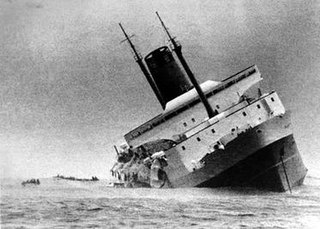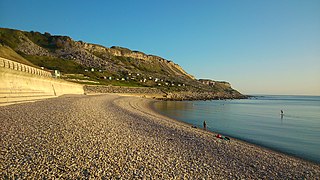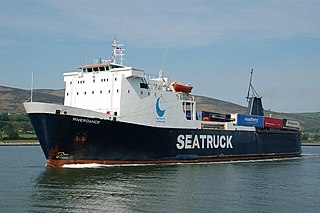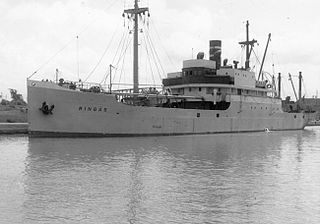
Chesil Beach in Dorset, England is one of three major shingle beach structures in Britain. Its name is derived from the Old English ceosel or cisel, meaning "gravel" or "shingle". It runs for a length of 29 kilometres (18 mi) from West Bay to the Isle of Portland and in places is up to 15 metres (50 ft) high and 200 metres (660 ft) wide. Behind the beach is the Fleet, a shallow tidal lagoon. Both are part of the Jurassic Coast and a UNESCO World Heritage Site, and together form an SSSI and Ramsar Site.

TEV Wahine was a twin-screw, turbo-electric, roll-on/roll-off ferry. Ordered in 1964, the vessel was built by the Fairfield Shipbuilding and Engineering Company, in Govan, Glasgow, Scotland for the Union Steam Ship Company's Wellington-Lyttelton Steamer Express Service in New Zealand. The ship's name, Wahine, is a word for 'woman' in some Polynesian languages, including Māori.

Chesil Cove is a curved steep bank forming the south-east end of 29-kilometre (18 mi) Chesil Beach in Dorset, England. It is thus part of one of three large shingle structures in Britain, extending from West Bay to the Isle of Portland, the latter acting more firmly as a great barrier (groyne) which stops tidal action from washing the beach away and leads to the high depositions by wind and tide action forming the grand curved bank of this "cove". The "cove", bill and much of Chesil Beach give shelter from the prevailing winds and waves for much of Weymouth Bay, the town of Weymouth and the village of Chiswell. It forms part of the Jurassic Coast.

The Royal Charter was a steam clipper which was wrecked off the beach of Porth Helaeth in Dulas Bay on the northeast coast of Anglesey, Wales on 26 October 1859. About 450 lives were lost, the highest death toll of any shipwreck on the Welsh coast. The precise number of dead is uncertain as the complete passenger list was lost in the wreck, although an incomplete list is retained in the Victorian Archives Centre in Victoria, Australia. The Royal Charter was the most prominent among about 200 ships wrecked by the Royal Charter Storm.

MV New Carissa was a freighter that ran aground on a beach near Coos Bay, Oregon, United States during a storm in February 1999 and broke apart. An attempt to tow the bow section of the ship out to sea failed when the tow line broke, and the bow was grounded again. Eventually, the bow was successfully towed out to sea and sunk. The stern section remained on the beach near Coos Bay. Fuel on board the ship was burned off in situ with napalm, but a significant amount was also spilled from the wreckage, causing ecological damage to the coast.

The SS Regina was a cargo ship built for the Merchant Mutual Line and home ported in Montreal, Quebec. Named after Regina, Saskatchewan, Regina had a tonnage of 1,956 gross register tons (GRT) and a crew of 32.

Riverdance was a roll-on/roll-off ferry in service with Seatruck Ferries on the Irish Sea. On 31 January 2008 she was hit by a wave that caused her cargo to shift and she beached at Blackpool, very close to the boundary with Cleveleys. Large amounts of the ship's cargo was spilled overboard after the ship ran aground, resulting in much of it being salvaged by members of the public. Attempts to refloat her failed, and she was scrapped on site during 2008.
Blackpool and the Fylde coast has become a ship graveyard to a number of vessels over the years. Most of the shipwrecks occurred at or near Blackpool, whilst a few happened a little further afield but have strong connections with the Blackpool area. For the purposes of this article, Blackpool means the stretch of coast from Fleetwood to Lytham St Annes.

SS James Eagan Layne was a liberty ship. She was beached and sunk during the Second World War off Whitsand Bay, Cornwall, United Kingdom.

The MV Ice Prince was a 328-foot Greek-registered cargo ship which sank in the English Channel on 15 January 2008, spilling 2,516 tonnes of timber, around 423 tonnes of intermediate fuel oil and 123 tonnes of marine diesel oil. Twenty crew members were rescued by HM Coastguard helicopter and Brixham lifeboat.

The SS Monte Carlo was a concrete ship launched in 1921 as the oil tanker SS Old North State. She was later renamed McKittrick. In 1932 she became a gambling and prostitution ship operating in international waters off the coast of Long Beach, California, United States, and was relocated to Coronado, California in 1936. The Monte Carlo was grounded on Coronado Island on New Year's Day 1937 during a storm and her wreck remains on the beach.

Francisco Morazan was a 1,442 GRT cargo ship that was built in 1922 as Arcadia by Deutsche Werft, Hamburg, for German owners. She was sold in 1934 and renamed Elbing. She was seized by the Allies in the River Elbe, Germany in May 1945, passed to the United Kingdom's Ministry of War Transport and renamed Empire Congress. In 1946, she was allocated to the Norwegian Government and renamed Brunes.

King Philip was a 19th-century clipper ship launched in 1856 and wrecked in 1878. The wreck of this ship is only rarely visible; very infrequently the timbers can be seen protruding from the sands of Ocean Beach, on the Pacific Ocean coast of San Francisco, California. The wreck is the "most complete remains of an American medium clipper." This is a shipwreck of one of many ships that were wrecked in and around San Francisco Bay.

The SS Benjamin Noble was a lake freighter that operated on the Great Lakes. Built in 1909 by the Detroit Shipbuilding Company, she was 239 feet (73 m) in length and had a beam of 40 feet (12 m). She was built as a "canaller," a vessel designed for use in what were then the dimensions of the Welland Canal, but was converted by her owners for services in the open Great Lakes. Heavily laden and top-heavy with a cargo of railroad rails, she sank in a Lake Superior storm near Knife River, Minnesota, in April 1914 with the loss of all hands.
Golden Grove was launched at Southampton in 1783, but probably under another name. In 1794 she was a slave ship. Under new ownership she wrecked in late 1795.

The Australasia was a wooden-hulled American Great Lakes freighter that served on the Great Lakes of North America between her construction in 1884 to her burning and sinking in 1896. On October 18, 1896, while loaded with coal, the Australasia sank in Lake Michigan near the town of Sevastopol, Door County, Wisconsin, United States, after burning off Cana Island. On July 3, 2013, the wreck of the Australasia was added to the National Register of Historic Places.
The Hive Shipwreck is a heritage-listed shipwreck site of the Hive, a former convict transportation ship located approximately 40 metres (130 ft) off Bherwerre Beach, Jervis Bay Territory, Australia. It was added to the New South Wales State Heritage Register on 1 April 2010.

PS Lotta Bernard was a wooden-hulled sidewheel steam barge that served on the Great Lakes from her construction in 1869 to her sinking in 1874. She was built in Port Clinton, Ohio, in 1869 by Lewis M. Jackson for S.W. Dorsey of Sandusky, Ohio. When she entered service, she was chartered by the Northern Transportation Company to carry cordwood from the Portage River and Put-in-Bay to Cleveland, Ohio. In 1870, Lotta Bernard was sold to Luman H. Tenney of Duluth, Minnesota. During this time, she was contracted to haul building materials from Bark Bay, Wisconsin, to Duluth to be used in the construction of the first grain elevator in that port. Lotta Bernard was sold to John D. Howard of Superior, Wisconsin, in 1871.
The Chesil Beach cannon consists of the remains of an unknown wreck were found on Chesil Beach, Dorset, England in 2010. The site was designated on 18 July 2017. The wreck is a Protected Wreck managed by Historic England.
















